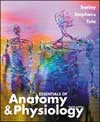 |  Essentials of Anatomy & Physiology, 4/e Rod R. Seeley,
Idaho State University
Philip Tate,
Phoenix College
Trent D. Stephens,
Idaho State University
The Endocrine System
Study OutlineFunctions of the Endocrine System
Water balance
Uterine contractions and milk release
Metabolism and tissue maturation
Ion regulation
Heart rate and blood pressure regulation
Blood glucose control
Immune system regulation
Reproductive function control
Intercellular Chemical Signals(Table 10.1, p. 262)Autocrine chemical signals
Paracrine chemical signals
Hormones
Neurohormones
Neurotransmitters
Neuromodulators and neurohormones
Pheromones
Receptors(Fig. 10.1, p. 263)Receptor types for intercellular chemical signals(Table 10.2, p. 264)Intracellular receptors(Fig. 10.2, p. 265)Membrane-bound receptors
Receptor responses
Membrane-bound receptor response
Ion channel responses(Fig. 10.3, p. 265)Activation of G-proteins(Fig. 10.4, p. 265)Production of intracellular signals
cAMP, DAG and IP3 as examples
Control of enzyme activity(Fig. 10.5, p. 266)direct activation of enzymes(Fig. 10.6, p. 266)phosphorylation of intracellular proteins(Fig. 10.7, p. 267) Intracellular receptor response(Fig. 10.8, p. 267) Hormones
Endocrine glands(Fig. 10.9, p. 268)Hormones and target tissues(Fig. 10.10, p. 268)Chemistry of hormones
Proteins, peptides and amino acid derivatives
Lipid hormones
Steroids
Eicosanoids
Regulation of hormone secretion
Blood levels of chemicals
Hormones
Nervous system
Endocrine Glands and Their Hormones(Table 10.3, p. 270-271)The pituitary and hypothalamus(Fig. 10-12, p. 273)Anterior pituitary
Releasing hormones
Hypothalamic-pituitary portal system
Posterior pituitary
Axons from hypothalamus
Hormones of the anterior pituitary(Tbl. 10-3, p. 270, Fig. 10.11, p.
272)Growth hormone (GH)Thyroid-stimulating hormone (TSH)Adrenocorticotropic hormone (ACTH)Gonadotropins
FSH
Female
Male
LH (ICSH)Female
Male
Prolactin
Melanocyte-stimulating hormone (MSH) Hormones of the posterior pituitary(Tbl. 10-3, p. 270, Fig. 10.11,
p. 272)Antidiuretic hormone (ADH; vasopressin)Oxytocin
Thyroid gland(Fig. 10.13, p. 275)Thyroid hormones (T4 and T3)Regulation of thyroid secretion(Fig. 10.14, p. 276)Calcitonin(Fig. 10.15, p. 278) Parathyroid glands
location(Fig. 10.13, p. 275)regulation of PTH secretion(Fig. 10.15, p. 278) Adrenal glandsClinical Focus: Hormones and Stressp. 285
Adrenal medulla - epinephrine(Fig. 10.16, p. 279)Adrenal cortex(Fig. 10.17, p. 280)Glucocorticoids - cortisol
Mineralocorticoids - aldosterone
Androgens
Pancreas, insulin and diabetes(Fig. 10.18, p. 281)Insulin-beta cells
Glucagon-alpha cells
Effects on target tissues(Table 10.4, p. 283)Regulation of secretion(Fig. 10.19, p. 282)Diabetes mellitus
Testes and ovaries
Testosterone - in males
Estrogen and progesterone - in females
Thymus gland-thymosin
Pineal body-melatonin
Other hormones
Digestive hormones
Prostaglandins - paracrine agents
Erythropoietin - from kidneys
From the placenta
Estrogens and progesterone
Human chorionic gonadotropin
Systems Pathology - Grave's DiseaseSystems Interaction Tablep. 287
|
|



 2002 McGraw-Hill Higher Education
2002 McGraw-Hill Higher Education